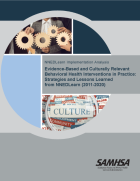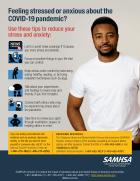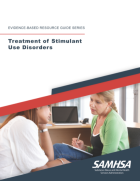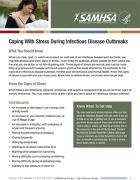This report provides findings from a qualitative analysis of evidence-based and culturally relevant behavioral health practices offered at NNEDLearn, a SAMHSA training, offered from 2011 to 2020. It includes an overview of NNEDLearn, case studies, strategies and lessons learned, and conclusion.
Dashboard: Filter Bricks
Main page content


This guide reviews ways that telehealth modalities can be used to provide treatment for serious mental illness and substance use disorders among adults, distills the research into recommendations for practice, and provides examples of how these recommendations can be implemented.

This issue brief presents recent data on prevalence of opioid misuse & death rates in the Hispanic/Latino population; contextual factors & challenges to prevention & treatment; innovative outreach & engagement strategies to connect people to evidence-based treatment; and the importance of community voice.

This flyer provides information and tips for coping during a pandemic as well as resources for additional assistance.

This guide supports health care providers, systems, and communities seeking to treat stimulant use disorders. It describes relevant research findings, examines best practices, identifies knowledge gaps and implementation challenges, and offers useful resources.

This quick guide contains an overview of the challenges associated with tobacco cessation and the benefits of being tobacco-free for individuals as well as those of a smoke-free workplace. It also includes tips that substance use disorder treatment settings can use to implement their own tobacco cessation programs.

This fact sheet provides Health Care Practitioners and Disaster Responders with guidelines for communicating with survivors experiencing grief. It give background information about the grieving process and what happens when the grief process is interrupted and complicated or traumatic grief occurs is included as well as helpful resources for additional assistance.

This manual offers guidance on how to engage youth during government-sponsored events and meetings. It includes resources to support youth services, youth development, youth leadership, civic engagement, and youth organizing.

This fact sheet provides tips for coping with stress during an infectious disease outbreak. It describes common signs of stress and how to recognize when to get help.

In a disaster, it's essential that behavioral health responders have the resources they need—when and where they need them. The free SAMHSA Disaster App offers first responders immediate access for any type of traumatic event at every phase of response, including pre-deployment preparation, on-the-ground assistance and post-deployment resources.
With the SAMHSA Disaster App, first responders can:
- Access resources including tip sheets; guides for responders, teachers, parents, and caregivers; and a directory of behavioral health service providers in the impacted area.
- Download information on your phone before deployment in case of limited Internet connectivity in the field.
- Review key preparedness materials to help you provide the best support possible.
- Send information to colleagues and survivors via text message, email, or transfer to a computer for printing.
- Find interventions to help survivors of infectious disease epidemics.
Find SAMHSA’s disaster response information as a publication. Download the SAMHSA Disaster Kit.
For more information, email SAMHSA at samhsainfo@samhsa.hhs.gov
Displaying 1 - 10 out of 15

